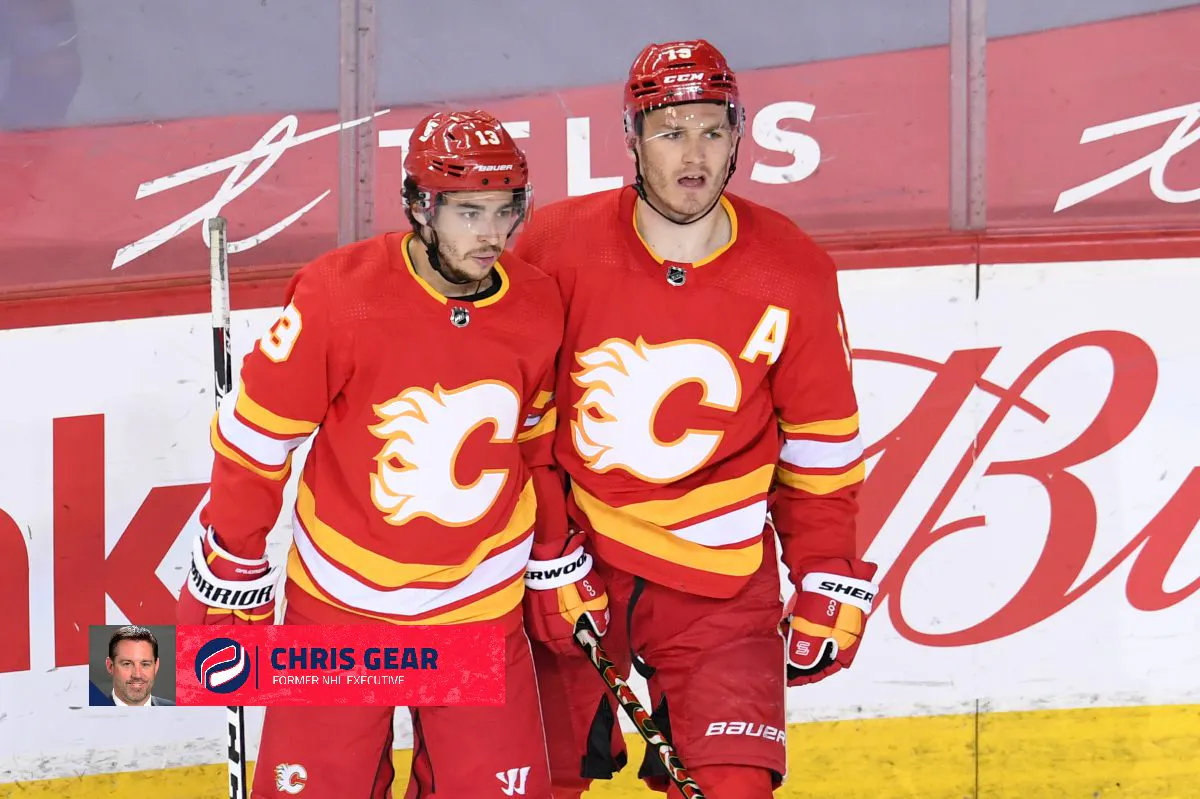How do the Calgary Flames sign all their star free agents this off-season?

Most of the time, having too many good players is a great problem to have. The one exception is when they all need a new contract at the same time.
Such is the dilemma the Calgary Flames find themselves in as the 2021-22 regular season draws to a close. With new deals needed for Hart Trophy candidate Johnny Gaudreau, fellow 100-point man Matthew Tkachuk and 35-goal scorer Andrew Mangiapane, not to mention rapidly improving defenseman Oliver Kylington, GM Brad Treliving and his hockey management group may just want to set up an off-season office at a bank.
If you’re a Flames fan, forgive me for bringing this up as the team gets set to embark on what may be a long and exciting playoff run. If you would rather enjoy the playoffs without worrying about the future cap challenges, put this in your saved folder for later. Otherwise, keep reading.
I’m not sure I can recall a situation where a team needed to sign three 35-plus goal scorers all in one off-season. It will be a significant challenge to overcome, but the good news is that there’s almost always a way to make the pieces fit if there’s a will to do so.
Treliving has stated publicly that the team will “move heaven and earth” to get a Gaudreau deal done, and you have to assume they feel the same about their young restricted free agents as well. Were “heaven and earth” just Treliving’s code words for “Sean Monahan and Milan Lucic”?
It is clear that something will have to give in order to free up the cap space to sign four players who need raises, especially the three who will be coming off offensive juggernaut seasons. Luckily, the Flames will start the summer with an extra $2.5 million to play with, thanks to the NHL-announced $1-million cap increase for next season and the disappearance of the $1.5-million Troy Brouwer buyout charge that will no longer be on the books following the 2021-22 season. They may even have the benefit of starting next season in LTIR if Monahan’s offseason hip surgery requires additional rehabilitation time. If they don’t start in LTIR, how much more will they need to make this all work?
Whether he wins the Hart Trophy or not, Gaudreau’s MVP-calibre season will net him a healthy payday. Flames fans who kept reading despite my warnings should look away now if they’re skittish, because one comparable Gaudreau could reasonably bring up is Artemi Panarin, whose seven-year deal at $11.6 million per season is one of the few unrestricted free agent pacts signed by a player whose platform year and career points per game at signing both exceeded 1.0. Panarin was a little younger at the time of signing (27 versus 29), but the comparison is not out of line.
The Flames, for their part, will want to observe Gaudreau’s playoff performance very closely before deciding on his value. It’s a given that Gaudreau is one of the most productive regular season players in the league, but can he be a factor in the playoffs? That question remains an open one, as Gaudreau has not fared that well in previous playoff appearances. Until he proves that he can handle the rigors of heavier, tighter-checking playoff hockey, any contract for Gaudreau would arguably need to be discounted significantly from what he might otherwise be entitled to.
Playoff performer or not, the Flames will likely also argue Gaudreau’s current year performance should also factor in that his two prior years, while solid, were not spectacular. I don’t think the four-year, $7-million-per-season deal signed by Max Pacioretty in 2018 or the eight-year, $7-million-per-season deal signed by Gabriel Landeskog last summer are truly comparable to Gaudreau after his stellar platform-year production, but any ability by Calgary to show the other deals as relevant comparisons based on prior years’ production will have a downward drag effect on Gaudreau’s final number.
Then there’s always the so-called “hometown discount” factor – how badly does ‘Johnny Hockey’ want to accept a reasonable number to keep the team’s core strong? If I’m Treliving, I’m playing that card with all my players. Make a little less but stay together and win.
A middle ground that might be satisfactory to both parties might be something like Jamie Benn’s 2016 contract or Mark Stone’s 2019 contract (both eight years, $9.5 million AAV) or Jeff Skinner’s 2019 deal (eight years, $9 million AAV). Their production was not on par with Gaudreau’s 2021-22 season, but each of Benn and Skinner earned their contracts following 40-goal seasons, and Stone was a perennial Selke Trophy contender.
Johnny Hockey turns 29 this summer (older than Benn, Stone or Skinner were at the time of their signings), so the Flames will have to be careful with term. Blake Wheeler signed a five-year contract at an $8.25-million AAV with the Winnipeg Jets in 2018 at age 32 following seasons of 78, 74 and 91 points and a career scoring rate of 0.78 points per game at the time of signing. Factoring in age and production, it isn’t a bad comparable for Johnny Hockey.
For argument’s sake, let’s say it takes $9.25 million per year to get Gaudreau done at a term Calgary likes. That eats up the $2.5 million in wiggle room I mentioned earlier. Assuming no other significant roster changes, there are still Tkachuk, Mangiapane and Kylington to worry about.
All three are restricted free agents, and all three have arbitration rights. The Flames will likely want to secure some term with all of them, especially Tkachuk, who would be an unrestricted free agent following a one-year deal, as would Mangiapane. Putting together enough money to buy some term will depend on what money can be moved out. The obvious choices to be moved are Monahan, who has one more year at a cap hit of $6.375 million and who, through injuries and poor play, has looked nothing like the player who put up 82 points in 2018-19 and could use a fresh start; or Lucic, who adds an important physical dimension to the Flames lineup but doesn’t deliver value approximating his $6-million cap hit.
Freeing up $6 million or more might do the trick, assuming the Flames were to add about $2 million to each RFA’s existing AAV. That would put Tkachuk at $9 million, Mangiapane at $4.4 million and Kylington at $2.75 million. Each of those might arguably be a little light (or you could reallocate the dollars among the three a little) depending on what term Calgary is prepared to offer to avoid arbitration. To be safe, the Flames may need to shed more than one contract.
Moving money is never easy, but it’s especially the case when you don’t have a deep draft-pick or prospect pool. The Flames have traded away significant draft capital to acquire pieces such as Tyler Toffoli and Calle Jarnkrok, so attaching yet another draft pick as incentive for another team to take on Monahan or Lucic is a dangerous proposition. With the Flames’ current roster and window for winning a championship, they likely hold their noses and get it done.
In the final analysis, there is a path for the Flames to retain all four players. Sure, it is a path littered with problems to be kicked down the road, but they are problems other teams would love to have.
____
Chris Gear joined Daily Faceoff in January after a 12-year run with the Vancouver Canucks, most recently as the club’s Assistant General Manager and Chief Legal Officer. Before migrating over to the hockey operations department, where his responsibilities included contract negotiations, CBA compliance, assisting with roster and salary cap management and governance for the AHL franchise, Gear was the Canucks’ vice president and general counsel.
Click here to read Gear’s other Daily Faceoff stories.
______

PointsBet Canada has officially launched in Ontario! Get a $25 free bet just for signing up right here!
Recently by Chris Gear
- Why the Buffalo Sabres and Detroit Red Wings won’t be Atlantic Division doormats next season
- Gear: How the Stanley Cup playoffs affect team revenues
- Gear: How player development staffs help prospects reach the NHL
- Gear: Why keeping draft picks can be as risky as trading draft picks
- Gear: Everything that happens after a player gets traded